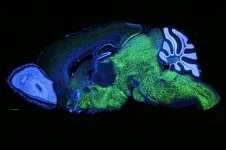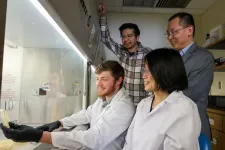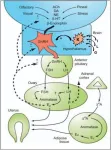(Press-News.org) *** Embargoed for release until Tuesday, Feb. 18, 2025, at 5 a.m. EST ***
A newly identified part of a brain circuit mixes sensory information, memories, and emotions to tell whether things are familiar or new, and important or just “background noise.”
Led by researchers from NYU Langone Health, the work found that a circuit known to carry messages from a brain region that processes sensory information, the entorhinal cortex (EC), to the memory processing center in the hippocampus (HC) has a previously unrecognized pathway that carries messages directly back to the EC.
Publishing online Feb. 18 in Nature Neuroscience, the study results show that this direct feedback loop sends signals fast enough to instantly tag sights and sounds linked to certain objects and places as more important by considering them in the context of memories and emotions.
“Ours is the first anatomical and functional analysis of both the new direct hippocampal-cortical feedback loop, and the indirect loop found decades ago,” said senior study author Jayeeta Basu, PhD, an assistant professor in the Departments of Psychiatry and Neuroscience at NYU Grossman School of Medicine. “The differences we found in their wiring, timing, and location suggest that the loops have separate but parallel roles that let them work together to encode even more complex information,” added Basu, faculty in the Institute for Translational Neuroscience at NYU Langone Health and a recent winner of the Presidential Early Career Award for Scientists and Engineers.
A better understanding of the interplay between the two brain regions may yield new solutions to problems within related circuits, researchers say, like those seen in patients with post-traumatic stress disorder who struggle to tell apart past trauma from current loud noises, or in the sensory overload experienced by some children with autism as they try to tell apart objects or interact with people.
Delicate Signals
The long-understood model of the studied circuit posits that the hippocampus (HC) receives sensory information about the outside world from entorhinal cortex (EC) surface layers 2 and 3, but sends back signals to the EC only by indirectly wiring first into a deep EC layer (layer 5), which then routes them into EC surface layers 2 and 3. The indirect route can cause time lags that change the HC feedback signals.
Using modern methods, the current research team found a second loop that directly connects the HC to EC layers 2 and 3, letting memories and emotions stored in the HC quickly add weight to perceived sights and sounds as part of learning. A paradox in the field has been that there is no known direct pathway connecting the hippocampal memory center with the brain’s emotional center, the amygdala. The newfound connections to the EC may serve as a crossroads.
Other results of the study map connections between brain cells based on their ability to pump charged particles through channels, building up charge imbalances (potentials) along their membranes. Upon receiving the right signal, cells open their channels, enabling the particles to rush out (depolarize) under electrochemical force, with charge flows acting like switches.
Brain cells in signaling pathways “fire” as their membrane potential shift, which causes each nerve cell’s extensions (axons) to depolarize until the electric pulse reaches a synapse, a gap between one cell and the next. When it reaches a gap, the electric pulse is converted into a chemical signal that either turns up (excites) or turns downs (inhibits) the strength of the message passed to the next cell, with their mixture sculpting signals underlying thoughts and memories.
Importantly, the current study measured these properties for the first time in both loops. Dr. Basu’s team found the previously known indirect loop to be excitatory, often triggering all-or-nothing signals called action potentials, large depolarizations that encode information based on their frequency.
The new direct feedback loop, however, in response to the same range of incoming signal strength, was found to recruit strong inhibition in brain cells (neurons) in EC layers 2 and 3, never eliciting action potentials. This newfound circuit activity instead sends small depolarizing potentials from the HC to EC layers 2 and 3. The authors say these delicate, repeated signals can combine with messages from other brain regions to make possible more intricate computations, accelerated learning, and greater plasticity, the strengthening of connections between neurons.
Moving forward, the research team plans to study how hippocampal output related to emotions and memories shapes decision-making functions in prefrontal cortex or the emotional coding of fear in the amygdala. The team will also examine what happens to their newfound direct circuit over the course of aging and in Alzheimer’s disease in study mice, and its parallels in humans.
Along with Dr. Basu, study authors from the the NYU Langone Institute for Translational Neuroscience were first author Tanvi Butola as well as Melissa Hernandez Frausto, Lulu Peng, Ariel Hairston, Cara Johnson, Margot Elmaleh, Amanda Amilcar, and Fabliha Hussain. Also authors were transgenic tool builder Cliff Kentros and his team members - Stefan Blankvoort and Michael Flatset, of the Kavli Institute for Systems Neuroscience at the Norwegian University of Science and Technology; along with Claudia Clopath, head of the computational neuroscience laboratory, Department of Bioengineering, Imperial College in London. Dr. Basu led a National Institutes of Health (NIH) BRAIN initiative project grant (2018-2023) with Drs. Clopath and Kentros to build the tools, approaches, and models used in current circuit mapping study.
The work was also supported by NIH grants R01NS109994, R01NS109362-01, 5013R01MH122391, RM1NS132981, Alzheimer’s Association grant AARGD-NTF-23-23 21151101, a Parekh Center for Interdisciplinary Neurology pilot research grant, a Mathers Foundation Award, a McKnight Scholar Award, a Klingenstein Fund – Simons Foundation fellowship award in neuroscience, an Alfred P. Sloan fellowship, a Whitehall research grant, an American Epilepsy Society junior investigator award, a Blas Frangione young investigator grant, New York University Whitehead fellowship for junior faculty, and a Leon Levy Foundation award.
###
About NYU Langone Health
NYU Langone Health is a fully integrated health system that consistently achieves the best patient outcomes through a rigorous focus on quality that has resulted in some of the lowest mortality rates in the nation. Vizient Inc. has ranked NYU Langone the No. 1 comprehensive academic medical center in the country for three years in a row, and U.S. News & World Report recently placed nine of its clinical specialties among the top five in the nation. NYU Langone offers a comprehensive range of medical services with one high standard of care across 6 inpatient locations, its Perlmutter Cancer Center, and more than 300 outpatient locations in the New York area and Florida. With $14.2 billion in revenue this year, the system also includes two tuition-free medical schools, in Manhattan and on Long Island, and a vast research enterprise with over $1 billion in active awards from the National Institutes of Health.
Media Inquiries:
Greg Williams (after Feb. 20)
212-404-3500
Gregory.Williams@NYULangone.org
David March (before Feb. 20)
212-404-3528
David.March@NYULangone.org
END
Newfound circuit better explains how the brain recognizes what is familiar and important
2025-02-18
ELSE PRESS RELEASES FROM THIS DATE:
A single protein may have helped shape the emergence of spoken language
2025-02-18
The origins of human language remain mysterious. Are we the only animals truly capable of complex speech? Are Homo sapiens the only hominids who could give detailed directions to a far-off freshwater source or describe the nuanced purples and reds of a dramatic sunset?
Close relatives of ours such as the Neanderthals likely had anatomical features in the throat and ears that could have enabled the speaking and hearing of spoken language, and they share with us a variant of a gene linked to the ability to speak. And yet it is only in modern humans that we find expanded brain regions that are critical for language production and comprehension.
Now researchers from The Rockefeller University ...
Scientists decode diet from stool DNA – no questions asked
2025-02-18
SEATTLE – Scientists have developed a breakthrough method to track diet using stool metagenomic data.
Developed by researchers at the Institute for Systems Biology (ISB), the new method, called MEDI (Metagenomic Estimation of Dietary Intake), detects food-derived DNA in stool samples to estimate dietary intake. MEDI leverages stool metagenomics, which refers to sequencing all the DNA present in fecal samples (including microbial, human, and food-derived DNA). This non-invasive, data-driven approach offers an objective alternative to traditional food diaries and questionnaires, ...
Biologists transform gut bacteria into tiny protein pharmacies
2025-02-18
Hundreds of different species of microbes live, laugh, and love in your gut. In the future, one of these might serve a new function: microscopic in-house pharmacist.
A new study published Feb. 18 in Nature Biotechnology shows how gut bacteria can be directed to produce and release proteins within the lower gastrointestinal tract — eliminating a major roadblock to delivering drugs to that part of the body.
Oral medication is the most common and practical means of drug administration, but the stomach doesn’t let much pass through unscathed. This is good when it comes to things like foodborne ...
Study sheds light on the genetics of stopping smoking
2025-02-18
The effectiveness of a common drug to quit smoking could be down to people’s genes, according to a study from the University of Leicester (United Kingdom).
Varenicline is widely recognised as the most effective medication for helping people stop smoking, but unfortunately it does not work for everyone.
Researchers from Leicester have uncovered important insights into how people’s DNA affects their response to the drug, which will soon be available to smokers through the UK’s National Health Service (NHS).
Varenicline ...
Landmark review maps complex interactions between sex hormones and neurological health
2025-02-18
MONTREAL, Québec, Canada, 18 February 2025 - A comprehensive review published today in Brain Medicine by leading neuroendocrinologist Professor Hyman M. Schipper from McGill University’s Department of Neurology and Neurosurgery maps out the extensive influence of reproductive hormones on neurological health and disease. This landmark review, appearing in a special Festschrift issue honoring Dr. Seymour Reichlin’s centennial, systematically examines how sex hormones affect a broad ...
Restoring African grassland habitats makes life more peaceful for humans and wildlife, scientists find
2025-02-18
Across Kenya, grasslands underpin people’s lives — as well as those of animals like elephants, giraffes, and hyenas. But the climate crisis is drying out these habitats, forcing people and animals to compete for resources, and increasing both community tensions and conflict between humans and wildlife. Researchers monitoring both grassland restoration and conflicts have now found that restoration can help reduce human-wildlife conflict and improve community relations: the more local grassland is restored, the less conflict there is.
“Grassland restoration is playing a role in reducing human-wildlife conflicts, social conflicts and the overall feeling of insecurity ...
Ventilation fans can significantly lower the risk of inhaling bacteria particles after toilet flushing
2025-02-18
Bioaerosol emissions during toilet flushing are an often-overlooked source of potential health risks in shared public facilities. A new study published in Risk Analysis found that bioaerosol concentrations of two bacteria -- Escherichia coli (E. coli) and Staphylococcus aureus (S. aureus) -- exceeded acceptable levels established by the Centers for Disease Control (CDC) after toilet flushing. Inhaling these biological particles can produce symptoms like abdominal cramps, nausea, diarrhea, and vomiting.
The research was conducted in two restrooms located in an office building in China. One contained a squat toilet and the other a bidet toilet. Scientists measured the emissions ...
Legionnaires’ disease from a lake swim
2025-02-18
Swimming in some lakes with still water can lead to infection with Legionella, bacteria that can cause pneumonia, and people who engage in open water swimming should be aware of this risk, say the authors of a practice article published in CMAJ (Canadian Medical Association Journal) https://www.cmaj.ca/lookup/doi/10.1503/cmaj.241086.
“Legionella infection represents a public health hazard owing to its ability to spread through exposure to natural water bodies and human-made water reservoirs,” writes Dr. Ashley Bryson, an internal medicine resident at the University of Manitoba, with coauthors.
Legionella infection is an atypical cause of community-acquired ...
New remotely-delivered support programme could deliver excellent care while saving the NHS and social care an average of £9000 a year for each person with dementia
2025-02-18
UNDER STRICT EMBARGO UNTIL UNDER STRICT EMBARGO UNTIL MONDAY 17 FEBRUARY 2025 AT 23.30 (UK TIME).
Peer reviewed | Randomised Controlled Trial | People
The NIDUS-Family package of care uses goal setting to help people with dementia live well at home for longer. New research from Queen Mary University of London in collaboration with UCL shows that, in addition to these known benefits, NIDUS-Family also reduces the costs associated with providing support to people with dementia.
Approximately ...
Global action needed to solve the medical oxygen crisis
2025-02-18
Targets for universal access, national roadmaps and more affordable and accessible care are vital to help fill the medical oxygen gap affecting more than half of the world’s population, according to a new global report.
The Lancet Global Health Commission report details for the first time how future investment in strengthening medical oxygen systems could have a huge impact by saving millions of lives and improving pandemic preparedness.
Almost 400 million children and adults require medical oxygen every year. More than five billion people, 60 per cent of the world’s population, don’t have access to safe and ...


